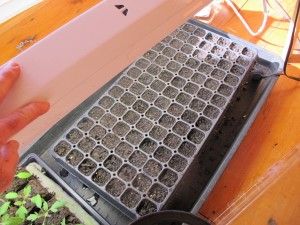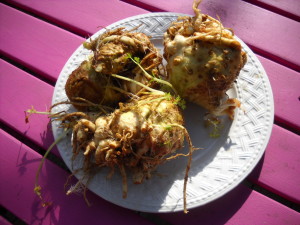More on Growing Great Veggies
This year Mother Nature, if she were a middle school student, would be at best a tease, and at worst a bully. Or maybe the Wicked Witch of the West. She gives us warm and sunny – then threats of snow or hail. Come on, Spring, let’s get with the program. We have veggies we want to plant!
Recently I wrote a column that promised tips on growing vegetables “A to Z: Artichoke to Zucchini” – but didn’t finish the B’s and skipped to zucchini. Huh. Today I’ll be less ambitious: The last of the B’s and most of the C’s. There really are a lot of great veggies we can grow.
Beets are best started outdoors once the soil temperature has warmed to 60 degrees or even warmer. Yes, they grow well in cool temperatures, but are slow to germinate in cold soil. Plant 2 to 3 inches apart, and be prepared to thin them in a month to 3 to 4 inches apart. Each “seed” is actually a seed capsule containing 2 to 6 seeds. They like soil that is near neutral in pH, so if you have acidic soil, add a little limestone. And they are deep rooted, so plant in fluffy soil for best results.
Hoping to jump the gun this year, I planted some beets in flats indoors on April 10. I started them on an electric seed warming mat but only got 20 percent germination, and the plants have long stems and are flopping over – even with bright fluorescent lights over them. I won’t do it again. I’ll plant mine outdoors this week.
Carrots also want fluffy light soil – and few if any stones. Comb through the soil carefully to get out rocks – I use a CobraHead weeder for that. Add lots of compost and some bagged organic fertilizer at planting time and again in early July.
Carrot seeds are tiny, but it’s worth your time to plant them individually, or nearly so. It will save a lot of time thinning them later on. Put seeds in the palm of one hand, and push one away from the rest with a pencil or pocket knife. Pick it up, plant it, and repeat. Tedious, yes. I like to plant them about an inch and a half apart, and thin to 3 inches when the thinnings are big enough to be worth eating.
Cauliflower is fussy. If it gets too hot or too cold it will “button” and not form a proper head. And unlike broccoli, cauliflower makes no side shoots (with rare exceptions). There is a purple one that I have grown, gorgeous in the garden but it turns gray when cooked.
Likewise, I don’t grow celery. It attracts slugs, gets woody and tough if the soil dries out, and is generally unsatisfactory. But I’m a serious cook and often need that celery flavor. Instead, I grow celeriac, also known as celery root. This is a great root crop that is pest free and stores for a long time. It’s funny looking with lots of roots that I cut off the bulb. Then I chop or grate it.
Celeriac, unfortunately, is not often sold in 6-packs at the garden centers. But it’s worth asking for it as the seeds germinate slowly and take a long time to get big. I planted mine on April 10 and they are just an inch tall 5 weeks later. Still, it will grow well into the fall so you could try planting seeds. Celeriac needs soil with plenty of moisture all summer.
I avoided growing corn for decades, instead I bought just a couple of ears at a time. I’m a bit like a raccoon: I tend to glut on it when there’s plenty in the garden ‘cause it’s so darn tasty! But for the past 2 years I have grown it. Here’s what I have discovered: you do need to plant it in blocks of 4 rows to get good pollination. And it needs plenty of supplemental nitrogen to do well. Last year I ran out of fertilizer and thought that since the soil was good, it would do fine. But corn in that section was short and spindly.
Fencing is probably the best to keep out coons, but I also used some solar powered blinking red lights that are said to scare them off (www.niteguard.com). Those are touted as deer repellents, too. I had some raccoon damage, but I probably needed more of them as the corn patch was very long. You need a minimum of 4 units to point in every direction.
Cucumbers are a summer favorite of mine, and I’ve already started some seeds indoors. They’ll go outside in mid-June after frost and when the soil is nice and warm, say 65 degrees. I used to plant seeds outdoors, but the plants were often killed by striped cucumber beetles that would strip off all leaves in a single night. Now I plant them when they have vines 6 to 12 inches long with some nice big leaves.
If you have had trouble with beetles but want to direct-seed your vine crops, you can cover the hills with row cover, also called Reemay. It is a thin agricultural fabric that breathes and lets sunshine and rain through. But sometimes the beetles, which emerge from the soil, are already waiting for you before you put it down. Be sure to rotate your planting sites for vine crops like cukes.
Mother Nature, if you’re listening: I’ve had it with this weather. Don’t make me release the flying monkeys.
Henry is now blogging twice a week. See the blog at https://dailyuv.com/




